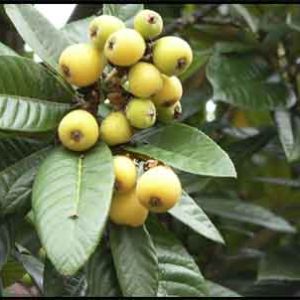Eriobotrya japonica
Loquat, Japanese medlar, Japanese plum
Origin
Loquat is a native of China and has been grown there for millennia. It was taken to Japan several hundred years ago and is now cultivated worldwide. The species is the only one in the genus cultivated for its fruit, with China by far the dominant producer.
Climate
It is a sub-tropical mild-temperate plant that needs precipitation of 1000-1200mm pa and grows within latitudes 20-35 degrees of the Equator, with extension to 45 degrees in maritime regions. Mature trees can withstand drought and several degrees of frost but flowers and fruit will probably be impacted. It can grow well in tropical climates but will bear very little or no fruit. Temperatures above 35°C will decrease pollination and cause sunburnt fruit.
Plant Description
A small evergreen tree, 5-7m tall, with a short trunk, rounded canopy and a shallow root system. The simple serrated alternate and coriaceous leaves are elliptical-lanceolate, 10-25cm long and 6-8cm wide, dark green on the upper side and downy beneath.
Relatives
In the large Rosaceae Family; these include: apple and pear, stone fruit, almond, quince, strawberry, medlar, raspberry and blackberry.
Soils
Undemanding if there is moderate fertility and good drainage, from light sandy loams to heavy clay and limestone, with an ideal pH of 6 but still possible with pH 5-8.
Propagation
Seeds are mainly useful as a rootstock source for budding and grafting, the main means of vegetative propagation. Rootstocks are usually loquat, but quince is also used. Cuttings are difficult.
Cultivars
Most established cultivars are the result of chance seedlings. There are probably hundreds of named cvs worldwide but some of those that can be sourced here are: Glenorie Superb, Bessel Brown, Enormity, Victory and Nagasaki-wase.
Flowering and Pollination
Inflorescences formed in autumn are terminal panicles of 25-80 fragrant flowers which are white with a 5-lobed calyx, 5 petals, 20-40 stamens and a central inferior ovary with 2-5 styles. Pollination is normally by bees. Rain during flowering negatively impacts fruit set. Although considered a self-compatible species, cross-pollination generally improves fruit set, size, sugar content and flesh/seed ratio.
Cultivation
They prefer full sun but will grow with some shade. Young plants should not be fertilized for the first several months. Once established, it is important to keep plants in an active state of growth as flowering is on terminal growth. Accordingly, moisture levels should be maintained not only after fruit set until harvest but also through the drying conditions of summer. Loquats are heavy feeders and they need adequate fertilization to produce quality fruit, with amounts increasing with tree size. Most of the annual amount should be given before flowering and the rest in early spring. As usual, compost is beneficial.
Wind Tolerance
Trees have only partial tolerance and too much wind when bearing can cause fruit skin abrasions. They are best planted in a sheltered location.
Pruning
When young they should be pruned to form an open scaffold of 3-4 main branches. Thereafter pruning involves skirting, removal of any dead wood, maintaining light penetration throughout the canopy and removing terminal shoots that have fruited. In ideal conditions, fruit thinning by cutting off 60-70% of each panicle leaving no more than 4-6 fruit is undertaken to enhance fruit size and minimize alternate bearing.
The Fruit
These occur in clusters of 3-20. They are oval or pyriform pomes, 2.5-5cm long, 30-40g, with white, yellow or orange smooth or downy skin and the remnants of the calyx at the apex. The flesh is white or yellow, sweet to sub-acid and surrounds normally 3-4 easily removed brown seeds. Seeds comprise 20-30% of fruit weight. They have 7-17% sugars and good levels of Fe and vitamin A.
Fruit Production and Harvesting
Cropping may begin within 3-5 years from planting. Harvest can be from early spring to early summer depending on cv and climate. Fruits should not be picked until fully coloured, and then the whole panicle is removed followed by individual fruits clipped off. Once trees begin cropping, yield will continue to increase over several years, often to more than 50kg/tree. Ripe fruits do not abscise and are easily bruised. They will keep for about a week at room temperature and up to a month in a crisper.
Fruit Uses
Fruit is usually eaten fresh, but they are also dried or processed in many ways. The downy skin is easily removed.
Pests and Diseases
The two main problems in WA are Medfly and birds – the first is usually controlled by baiting and/or spraying and the second by netting.
Comments
Loquats are easy to grow in our climate. If the purpose in having one is ornamental or to provide a screen or shade then a seedling-grown plant will suffice. But if you want good yields of tasty fruit then you should obtain an established cv. They supply fruit at a time of year when not many others are cropping. Medfly and birds will need to be managed.
